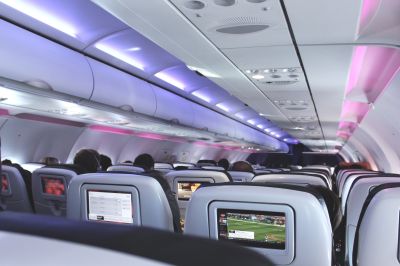The TSA just reported an all-time high for the number of airline travelers screened, and major U.S. airlines expect to transport 271 million passengers this summer, a 6.3 percent increase from last year.
Board-certified infectious disease physician Carl Abraham, MD, assistant professor at New York Institute of Technology College of Osteopathic Medicine (NYITCOM), arms passengers with valuable information to stay healthy at 35,000 feet. Abraham, a practicing physician and faculty member at the medical school’s Arkansas location, notes that some people may actually be surprised about the risk of germ spread on most airplanes.
“Commercial airplanes contain high efficiency particulate air (HEPA) filter systems, which exchange the air rapidly. In general, the risk of spreading an airborne pathogen is lower in an airplane than other indoor, public settings,” he says. “However, some studies suggest that sitting within two rows of an infected passenger does increase the risk of acquiring an airborne infection.”
Given this, Abraham urges anyone with a possible respiratory tract infection to wear an N95 mask, as well as those with compromised immune systems.

Carl Abraham, MD. Courtesy of New York Institute of Technology College of Osteopathic Medicine
“Disinfecting touched objects, like seatbelts or trays, won't hurt, although airlines are supposed to make sure areas are cleaned thoroughly between flights,” says Abraham.
But the real hotspot might be the airplane lavatory. Here, transmission can occur either by coming into contact with surfaces contaminated by bacteria or by inhaling air contaminated with certain viruses—like influenza, SARS-CoV-2, and measles—after being used by a contagious passenger. Transmission of norovirus, the common cause of diarrheal outbreaks on cruise ships, has also been reported.
“In general, the surfaces of public restrooms are frequently contaminated with fecal flora, bacteria found in stool. Airplane restrooms that are shared between passengers are no exception,” says Abraham. “And, although airlines clean the lavatory between flights, their use during the flight results in contamination of the toilet, sink handles, door handles—inside and outside, and especially the floors. Bacteria from the bathroom can also track into the cabin on the bottom of our shoes.”
To avoid coming into contact with these germs, he advises passengers to open and close lavatory door handles with a sanitizing wipe, use toilet seat covers, and close the lid before flushing.
“Importantly, everyone should always wash their hands or practice some form of hand hygiene before putting clothes back in place and before and after eating,” says Abraham.
Source: New York Institute of Technology
